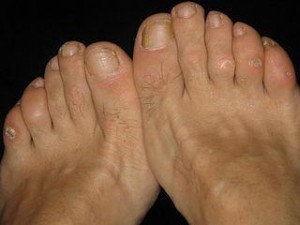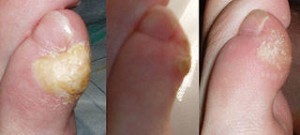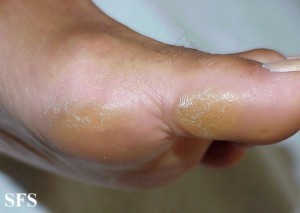Corns and Calluses (Feet) Causes, Pictures, Treatment
The skin is has to deal with a host of insults from the environment throughout the day. It is fair to say that the skin on the feet is by far the most strained as it bears the entire body weight and is often cramped into tight shoes for hours on end. Corns and calluses are two skin conditions that commonly affect the feet. Most of us consider it to be nothing more than an unsightly bump on the feet but it can be quite uncomfortable for a person who has it and affect walking and standing.
Meaning of Corns and Calluses
Corns and calluses are similar skin conditions that occur on different parts of the feet. However, they are not the same. Both corns and calluses should not be confused with a bunion which is a bony bump at the base of the big toes. The skin over bony bump becomes red and sore. Sometimes a similar type of bony bump can occur on the little toe which is known as a bunionette.
What is a corn?
A corn is thickened skin that forms on the top and the sides of the toes. It tends to occur on areas that do not bear weight. Although usually painful, a corn is not considered to be a problem in people who are healthy. It may therefore not require treatment if it is not causing any pain or discomfort.
What is a callus?
A callus is also thickened skin that forms on the feet but affects the weight bearing areas like the soles. It can also occur on the hands. Calluses are usually larger than corns but are rarely painful. The size and shape of a callus can vary. As with corns, it is only a medical problem for people who have underlying conditions like diabetes or circulatory disturbances.
Causes of Corns and Calluses
Both corns an calluses occur due to repeated pressure and friction on the same area of the skin. As a result the skin thickens and hardens forming the unsightly bumps that we refer to as corns or calluses. This thickening and hardening of the skin is the body’s way of protecting the affected area. The process of skin thickening is known as hyperkeratosis. Similar skin reactions can occur anywhere on the body but the feet and hands are the areas that are more prone to these skin changes due to repetitive activity.
Calluses can develop over bunions due to the constant friction of the bony bump against the inside of a shoe. However, this does not mean that a callus is a bunion. Similarly corns and calluses are more likely to occur in people with other foot problems such as hammertoe and bony outgrowths like calcaneal spurs. Corns and calluses on the feet are almost entirely due to wearing hoes that are too tight. This causes repeated pressure and friction against the feet. However, even loose fitting shoes can be a problem as the foot has more space to move around and rub against the insides of the shoe.
Signs and Symptoms
As mentioned, corns and calluses are similar conditions but not the same. Corns are smaller than calluses. Corns also tend to be painful while calluses rarely cause any pain. The thickening and hardening of the skin that forms into corns and calluses does not occur overnight. Usually there are early symptoms like tenderness of the skin in the area before it forms. This initial tenderness may quickly resolve as the skin thickens and hardens over time to eventually form a visible callus or corn.
Most people only seek treatment for a corn or callus once it is visible and cause significant discomfort. Both a corn and callus appears as:
- Thick and hard skin.
- Rough bump on the skin.
- Flaky and dry skin.
- Pain and tender bumps (more in corns).
- Bleeding (sometimes).
People who suffer with diabetes (particularly long term and poorly controlled diabetes) as well as people who problems with the circulation in their feet are prone to complications of corns and calluses. The area can form an open sore (ulcer) that heals poorly and infections may even arise in the area.
Pictures of Corns and Calluses
Picture of corns on the toes
Picture of a callus on the toe
Picture of a callus on the sole of the foot from Dermatology Atlas Brazil
Home Remedies
There are many non-medical measures to treat corns and calluses. These home remedies are very effective and should be the first option for treating the corn or callus provided that there is no ulceration or infection.
- The first and most important step in remedying a corn or callus is to use appropriately fitting footwear. Shoes should not be too tight or too loose. Socks should also be used where possible.
- Remove thickened skin using a pumice stone or nail file. However, it should be done carefully and the skin should not be thinned till its raw. Soak your feet in warm water to soften the skin before thinning the area.
* Diabetics and people with circulatory problems should not do this on their own due to the risk of infections. A podiatrist can treat corns and calluses for them. - Soften the skin with the good quality moisturizers. It should be applied several times in the day if possible and immediately after bathing and drying the area.
- Place pads over the affected skin like the over-the-counter non-medicated variety for corns and calluses. Avoid the medicated corn pads especially if you are diabetic or have impaired blood flow in the feet and legs.
- Use custom-made shoe inserts (insoles) as prescribed by a podiatrist for people with foot deformities. It can help reduce the friction and pressure and prevent the formation of corns and calluses.
Treatment of Corns and Calluses
Medical treatment is always advisable for severe corns and calluses that do not respond to conservative measures as outlined under home remedies. Podiatrists are trained medical professionals who deal with foot problems. Even though a corn or callus may seem like a minor problem, it is always advisable to have it assessed by a medical doctor or podiatrist. Diabetics and people with blood flow problems in the legs and feet should first consult with a podiatrist before attempting to treat the corn or callus with home remedies.
The professional treatment of corns and calluses may seem to be similar to some of the conservative measures that are done at home. A scalpel may be used by a medical professional to cut and trim the excess skin. Never use a sharp object to remove thickened skin at home. Medicated corn and callus patches may also be used when advised by a doctor. When there is an infection or a high risk for infection, antibiotic creams may need to be used over the affected area. Surgery to correct bone abnormalities may be necessary in severe cases but this is rarely done.
References:








